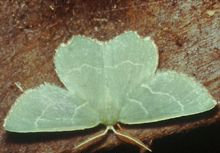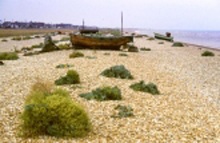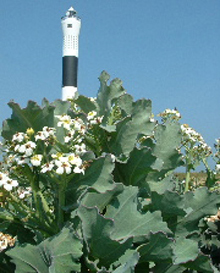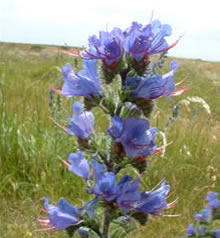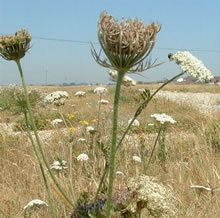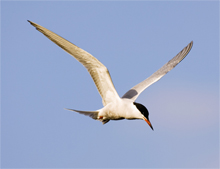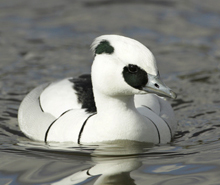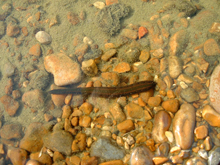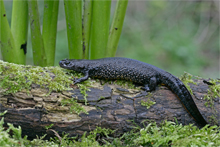WILDLIFE
Dungeness is a hostile landscape but it has many distinctive plants which favour the pebble habitat close to the sea. Blackthorn grows in a prostrate form as do the yellow flowered broom bushes which hug the shingle landscape. The blackthorns in particular can be smothered in lichens due to the clean air.
Dungeness is rich in an array of insects, notably its moth species. One speciality is the Sussex emerald moth, which is a night flying green moth which appears in July. The caterpillar feeds on wild carrot which is a relatively common plant in Britain. However, Dungeness is the only place in Britain where this moth is found. Another rarity is the pygmy footman moth which is supported by the lichen community at Dungeness. To find out more about the moth population you can look at The Moths of Dungeness website.
If you would like to find out more about recent wildlife sightings at Dungeness, from the latest migrant bird or the complete plant list, to butterfly and moth sightings, visit the Dungeness Bird Observatory website or the RX wildlife website which includes sightings from Hastings to Romney Marsh, both websites are updated daily.
PLANTS
Sea kale Crambe maritima
This plant is similar to cabbage both in it’s appearance and in its properties. Sea kale grows in clumps of waxy grey-green leaves similar in shape to cabbage leaves. In the past people used to blanch the leaves by piling shingle on top of them, then cooking and eating them as we would cabbage. This plant produces dense clusters of white flowers from June to August.
Viper’s bugloss Echium vulgare
The name ‘bugloss’ is Greek in origin meaning ox’s tongue and the likeness can be easily seen. Not only are the leaves of similar shape but they are rough like an ox’s tongue . This plant is particularly useful for some invertebrates as its hollow stems provide a place for them to over-winter. Humans have found uses for this plant including boiling the seeds in wine, the resulting concoction was said to ‘comfort the heart and drive away melancholy’.
Nottingham catchfly Silene nutans
The Nottingham catchfly is no longer in Nottingham, but Dungeness does support a large community of this rare plant. Nottingham catchfly’s habitat is limestone rocks and shingle and was famous for growing on the walls of Nottingham castle until the 19th century. The fragrant drooping white flowers of this plant open at night between May and August.
Wild carrot Daucus carota
Wild carrot is a common plant growing in various habitats and is an ancestor of the cultivated carrot. The plant produces no edible root but has been used for medicinal purposes for centuries as it is believed to have diuretic and stimulant properties. The scientific name is suggestive of this as Daucus originates from the Greek ‘dais’ meaning to burn.
INVERTEBRATES
Emperor dragonfly Anax imperator
The adult male emperor is bright blue and the largest dragonfly in the UK. It is one of the fastest flying insects and can often be seen patrolling over the gravel pits at Dungeness. With it’s delicate wings beating 30 times a second, the male emperor is rarely still as he fiercely defends his territory.
Small copper Lycaena phlaeas
This small butterfly can be seen from late April to the end of October and is common at Dungeness. The small copper is also very territorial and the adult male can often be seen perching on or near the ground ready to purse any passing butterfly.
BIRDS
Common Tern
A summer visitor to the UK, it breeds on the islands at the large gravel pits on the RSPB reserve and feeds offshore diving for fish.
Smew
Dungeness is one of the best places to see this striking white duck which arrives for the winter months. The smew is a small duck and can be seen diving to search for underwater food such as fish and insects.
Wheatear
One of the earliest migrants returning from Africa, the wheatear can be seen from March to October. It is a small bird that spends much of its time on the ground where it nests and hunts for insects and larvae.
RSPB
The RSPB manage large areas of gravel pits, reed beds and shingle habitats which have strong colonies of seabirds, breeding duck and wintering wildfowl.
To discover more and explore the Dungeness RSPB reserve, why not visit the reserve with its visitor and education centre. Facilities include a large car park and toilets. You can also explore a number of nature trails and hides around the gravel pits of Dungeness.
Contact the RSPB on 01797 320588. email [email protected] or visit their website.
AMPHIBIANS
Great-crested newt
This is the rarest and largest of the three species of newt found in the UK. Many of the flooded pits at Dungeness hold healthy populations. Up close these creatures look almost prehistoric with warty skin, a shaggy crest and large tail and a bright orange belly.
ANNELID
Medicinal Leech
The largest of the leeches in Britain, it feeds on the blood of fish, amphibians, birds and mammals. The medicinal leech is the only leech in this country able to suck blood from humans. The belief that these leeches could extract bad blood and leave the good behind lead to over collecting across Europe and a severe decline in the leech populations. Dungeness is now one of the best areas in Europe to find them.
